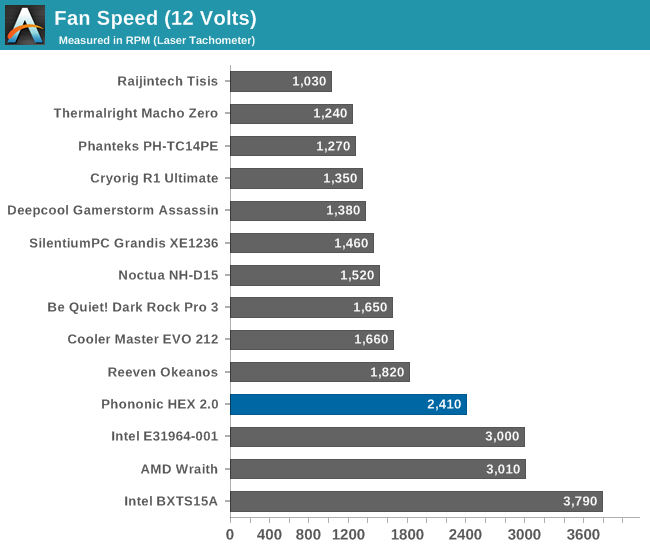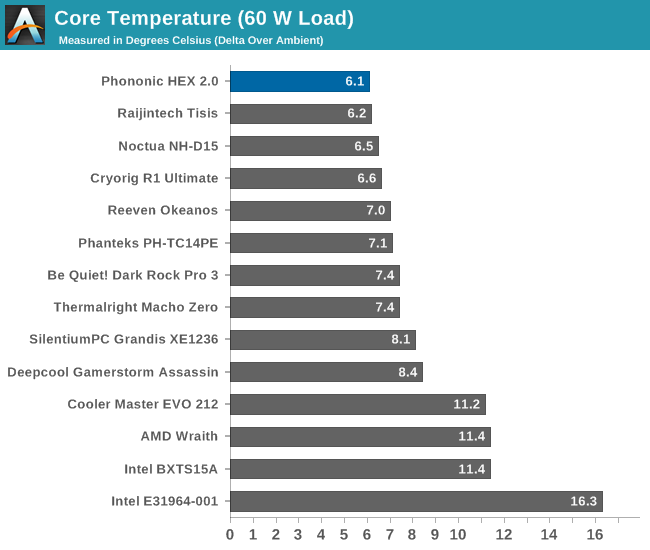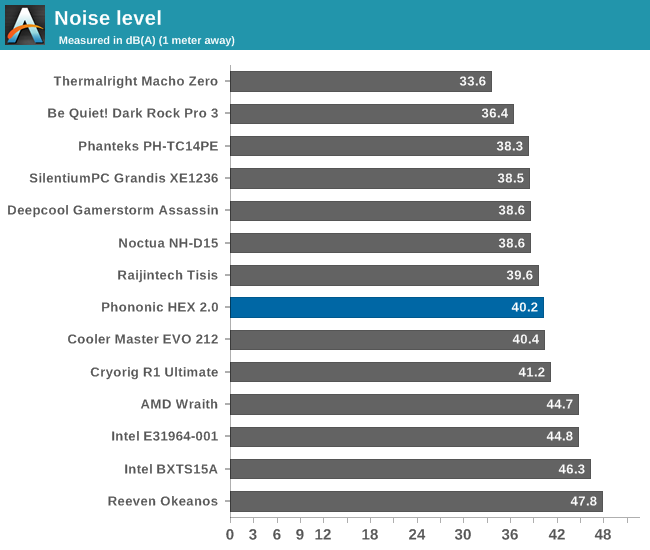The Phononic HEX 2.0 TEC CPU Cooler Review
by E. Fylladitakis on September 26, 2016 9:30 AM EST- Posted in
- Cases/Cooling/PSUs
- Cooler
- TEC
- Phononic
- HEX 2.0
Testing results, maximum fan speed (12 Volts)
The thermal performance of the Phononic HEX 2.0 is a relatively complicated topic. Most typical coolers have a relatively steady absolute thermal resistance regardless of the load or, depending on the cooler’s mass, the absolute thermal resistance slightly decreases as the temperature difference increases. The HEX 2.0 shows the completely opposite behavior; it’s absolute thermal resistance is very high at lower loads but it sharply degrades at higher loads. This happens because, in layman’s terms, the TEC cannot cope with the excessive thermal energy while, at the same time, it inserts its own thermal losses into the system, leaving the relatively small tower cooler to cope with much more than just the chip it is supposed to be cooling.


| Core Temperature, Constant Thermal Load (Max Fan Speed) |
The average thermal resistance of the HEX 2.0 is 0.1459 °C/W, which seems to be poor considering the target audience of this cooler. However, the thermal resistance of the cooler with a low thermal load of 60W is 0.1017 °C/W, easily rivaling the largest of tower coolers and even liquid cooling solutions. As the load increases, the thermal resistance of the HEX 2.0 decreases, particularly with thermal loads above 200W. With a thermal load of 340W, the thermal resistance of the HEX 2.0 drops down to 0.1685 °C/W, hardly competing with the performance of budget-oriented and stock coolers.

As for the energy consumption, the HEX 2.0 will almost entirely disable the TEC for thermal loads below 20W to minimize consumption and will prevent condensation issues. It will not push the chip to temperatures below the ambient in its balanced mode. If set to the insane mode, the TEC will always operate at maximum mode and could possibly get the CPU to register temperatures below the ambient, but only if the thermal load is very low.

Aside from it turning the TEC off completely, the TEC controller virtually has two operation modes; half power and full power. The controller decides when to set each mode depending on the thermal load and the ambient temperature. Roughly, the TEC shuts down for a thermal load below 15W, it operates at half-power mode for a thermal load between 15W and 90W, and goes at full-power mode for a thermal load above 90W. The TEC itself consumes about 20W at half power mode and 40W at full power mode, with the exact value slightly varying depending on the temperature. Note that a large percentage of this energy consumption is inserted as additional thermal load for the cooler to dissipate.










48 Comments
View All Comments
MrSpadge - Tuesday, September 27, 2016 - link
"As the load increases, the thermal resistance of the HEX 2.0 decreases, particularly with thermal loads above 200W. With a thermal load of 340W, the thermal resistance of the HEX 2.0 drops down to 0.1685 °C/W"Yep.. this should be:
"As the load increases, the thermal resistance of the HEX 2.0 INCREASES, particularly with thermal loads above 200W. With a thermal load of 340W, the thermal resistance of the HEX 2.0 INCREASES UP to 0.1685 °C/W"
bug77 - Tuesday, September 27, 2016 - link
Oh goodie. A cooler with Windows-only software. Where do I sign up? /sBulkSlash - Tuesday, September 27, 2016 - link
It's great to see someone experimenting with TECs again, I think the last time I used one was with the ATI Radeon 800 XT! It's a pity this doesn't really work for really high temperatures as that's really where a TEC can come into its own.Haravikk - Wednesday, September 28, 2016 - link
Seems like some odd choices. For me it always seemed like a TEC made most sense as an external unit for liquid cooling, since the liquid can transfer the heat out and the TEC then cools it somewhere that the condensation problem can be controlled. Plus externally you can have a massive heatsink or even a huge plate for dissipating passively.Trying to squeeze it inside a case like this just doesn't seem all that practical, and it doesn't really seem to offer much in the way of advantages; I'm not that fussy about how cool my processor is when it's idle so long as my fans are quiet at that point. Most good coolers will keep a CPU from exceeding 40-50ºC under light load without making too much noise (some will even do it passively in the right case) so I just don't see what this unit offers for the price and complexity.
Also, while aesthetically I like the fan in the middle, practically I don't see the point; horizontal space usually isn't so tight that you can't fit the fan on the front or back of the cooler, plus with that design it's easy to provide mounts for a second fan. Sandwiching in the middle just seems like it limits the heatsink unnecessarily.
dave_the_nerd - Wednesday, September 28, 2016 - link
On one hand, this is a compact, nice looking cooler that performs very well with the 50-65w TDP CPUs that Intel makes and sells.OTOH, I really want a Reeven Okeanos now.
zodiacfml - Saturday, October 1, 2016 - link
Other reviews were not able to find that advantage at low loads.The question now is, which chips are suitable for overclocking to 65W. If it did, will it improve highest possible overlclock?
Sunburn74 - Tuesday, October 4, 2016 - link
Was I the only one who thought the conclusion was a bit off? Why didn't the reviewer just say it's a bad product at a terrible price point? I mean, it appears to be that there is always a smaller, quieter, cheaper and equally if more efficient cooling option in almost every situation testedSadler2010 - Monday, August 22, 2022 - link
I used to run an Ultra Chilltec Black until the Peltier died it successfully cooled a Phenom II 970T and my FX-8350 until it flatlined. So my experience with TEC's was good, but now I'm looking at AIO's to avoid the issues brought by TEC's.